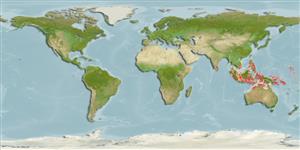Klassifizierung / Names
Namen | Synonyme | Catalog of Fishes(Gattung, Arten) | ITIS | CoL | WoRMS | Cloffa
>
Gobiiformes (Gobies) >
Gobiidae (Gobies) > Gobiinae
Etymology: Eviota: No etymology given, suggested by Christopher Scharpt: from Latin 'eu' for 'true' and 'iota' for anything very small, in combination 'truly very small' referring to it as being the smallest vertebrate at the time it has benn described by Jenkins (thus, making the suggestion by Scharpt plausible; rubrisparsa: Name from Latin 'rubrum' for red and 'sparsus' or sprinkled, referring to the live color pattern of red dots.
More on authors: Greenfield & Randall.
Environment: milieu / climate zone / depth range / distribution range
Ökologie
seewasser riff-verbunden; tiefenbereich 20 - 28 m (Ref. 83982). Tropical
Indo-West Pacific: Christmas Island (Indian Ocean), Indonesia (Flores, Alor, West Papua), Papua New Guinea (D'Entrecasteaux Islands and New Britain), Solomon Islands.
Size / Gewicht / Alter
Maturity: Lm ? range ? - ? cm
Max length : 2.0 cm SL Männchen/unbestimmt; (Ref. 83982)
Kurzbeschreibung
Bestimmungsschlüssel | Morphologie | Morphometrie
Rückenflossenstacheln (insgesamt) : 7; Rückenflossenweichstrahlen (insgesamt) : 9; Afterflossenstacheln: 1; Afterflossenweichstrahlen: 8. This species is distinguished from its congeners by the following set of characters: dorsal/anal fin-ray formula 9/8; pectoral fin rays 16-19 (mean 18), 5-6 lower rays branched; cephalic sensory-pore system pattern I (complete); fifth segmented pelvic-fin ray 11.5-22% of fourth; branches on fourth pelvic-fin ray 5-7, 3 segments between branches; non-fimbriate genital papilla; dorsal fin filamentous (to 36.9% SL); body with no distinct large dark marks; anal fin and lower half of caudal fin dark; scattered melanophores behind eyes on nape; when alive, small red dots cover the body but these disappear when preserved in ethyl alcohol (Ref. 83982); characterized further by longitudinal scale series 25; ctenoid scales, none on head, nape, breast and pectoral fin base; depth of body 4.7-5.6 in SL (Ref. 90102).
Inhabits sand-rubble bottoms among reefs in 4-15 m (Ref 90102).
Life cycle and mating behavior
Geschlechtsreife | Fortpflanzung | Ablaichen | Eier | Fecundity | Larven
Greenfield, D.W. and J.E. Randall, 2010. Four new gobiid fishes of the genus Eviota from the Western Pacific, with clarification of Evoita guttata and Evoita albolineata (Teleostei: Goblidae). Proc. Calif Acad. Sci. 61(3):269-289. (Ref. 83982)
IUCN Rote Liste Status (Ref. 130435: Version 2024-2)
Bedrohung für Menschen
Harmless
Nutzung durch Menschen
Tools
Zusatzinformationen
Download XML
Internet Quellen
Estimates based on models
Preferred temperature (Ref.
123201): 27.2 - 28.3, mean 28 °C (based on 7 cells).
Phylogenetic diversity index (Ref.
82804): PD
50 = 0.5000 [Uniqueness, from 0.5 = low to 2.0 = high].
Bayesian length-weight: a=0.00692 (0.00284 - 0.01683), b=3.10 (2.92 - 3.28), in cm total length, based on LWR estimates for this Genus-body shape (Ref.
93245).
Trophic level (Ref.
69278): 3.0 ±0.3 se; based on size and trophs of closest relatives
Fishing Vulnerability (Ref.
59153): Low vulnerability (10 of 100).
